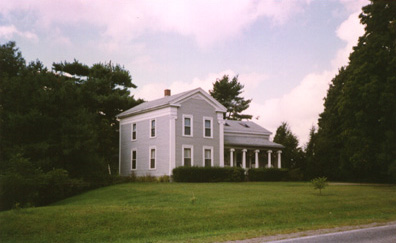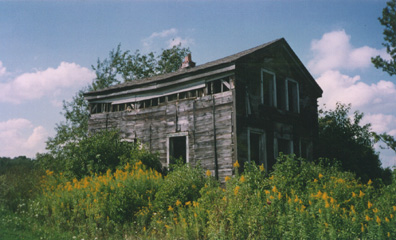
by Virginia Wilson
(C) 1993,1998 Grafx Computing

Greek architecture, as opposed to Roman, became known to western culture in about 1750. It was first regarded as primitive and was not widely imitated.
In 1791 Peirre Charles L'Enfant, a French engineer who served in the Revolutionary War, completed plans for our nation's capital, the city of Washington. In 1800, the city was founded. The European architectural style of that time was Roman Revival and it was beginning to modify the simpler Colonial taste of America. The earliest building to be completed, in Washington, was the "White House" or Executive Mansion. It was designed by the Irishman Thomas Hoban and showed the stamp of a neoclassical architecture that combined Roman and Greek influences. It had affect on style throughout America.
The Greek style imitated the construction of classical Greek temples, not the homes of ancient Greeks. The earliest temples were originally constructed in timber, but later ones were built of marble. They were stark in form; simple rectangular massing with gabled roofs. It was the rich and formal detailing of the buildings that distinguished the architecture. The styles the Greeks used fell into orders; Doric, Ionic, Corinthian, etc.
The Grecian fashion in Europe had started in the 1780's and was gaining strength. Amongst the earliest believers in the positive value of the simplicity and gravity of the Greek style were the Englishmen Soane and Gilly; the Frenchman, Ledoux; the German, Smirke and the Scotts Playfair and Hamilton. As an international architectural style, the Greek Revival culminated in the decade of the 1830's. Perhaps the most famous practitioner in America was Benjamin Henry Latrobe. He was an Englishman, relocated to Virginia, who is most famous for his work on the US Capitol building, finished in 1817.
In the early 1800's western New York was just being settled by European Americans. Here, in the first few decades of the Nineteenth Century, the Federal style was popular. But by the 1820's it gave way to the Greek Revival style. The Greek style continued to be built in America up to the time of the Civil War.
Most of the Greek Revival built in our area of western New York was in Ionic Order. This was typified by the representation of curled writing scrolls at the tops of the columns. Some homes followed the earlier Doric Order. It was simple, yet elegant. Perhaps the best local example is the Edward's Insurance building on East Main Street in the village of Panama.
The Greek temples had porticoes (covered entry porches) that were rimmed by free-standing columns. Most Greek Revival homes in our area had free standing Greek columns only on side porches. The house itself featured engaged columns. In some cases the fidelity to the formalities of the Greek orders could be questioned.
Sometimes only a rough stylization was accomplished; nonetheless, the message got through. To understand that message, it's important to realize some things about our area at that time.
These homes were built at a time when rural America was getting past the stage of scratching survival from the land. In America, the philosophy of Transcendentalism was having profound effect on such diverse areas as religion, economics, literature and art. The work of Emerson and Thoreau are examples. Some have called this period before the Civil War the American Renaissance.
Moreover, at this time Buffalo was emerging as the grain milling capital of the western world. The Erie Canal and the railroads were beginning operations, and this corner of western New York was becoming the cosmopolitan crossroads between Pittsburgh, Detroit, Cleveland, Chicago and Buffalo. A golden period of gentlemen farmers living in simple elegance was dawning. The farmer was seen as engaged in a noble activity. What better place to live than a white Greek temple on a beautiful green hillside.
Western New York has a well known tradition in Greek Revival. A past architectural historian at the SUNY campus in Fredonia, Jewel Helen Conover, wrote a book titled Nineteenth Century Houses in Western New York. In it, she names Panama as the Athens of western New York for its plentiful and fine examples of Greek Revival homes.

Some of these houses were lost in the Depression. In the 1930's many homes fell into disrepair. I remember paint peeling from columns and laundry hung on the porches. People were often poor and could not maintain their homes well.
Some houses have been lost more recently. The house of Judge Wellman on 474 near Randolph Road was one of the most beautiful examples of Greek Revival architecture anywhere. It tragically burned to the ground in 1991 after being hit by lightning. It was originally built in 1840 for Thadeus Steward by the architect and builder John Capple.
John Capple also built the house containing Edward's Insurance (see Gallery). It was designed for Dr. Corneleus Ormes in 1833. Others, at that time in this area, who built Greek Revival style were Samuel Brown, John Jones, George Losee and John Hewhouse. Some were architects, but others were carpenters or wood carvers.
They and other unidentified contemporaries have left Panama a rich heritage. In recent years awareness of these treasures has grown and that awareness has been reflected in restoration and maintenance efforts we see in the photographs on the following pages.
Unfortunately, space confines us to include only a
sampler of some of the fine examples of Greek Revival in our area. If
we missed your place, send us a photo and details on your home and
perhaps we can do a follow up article.